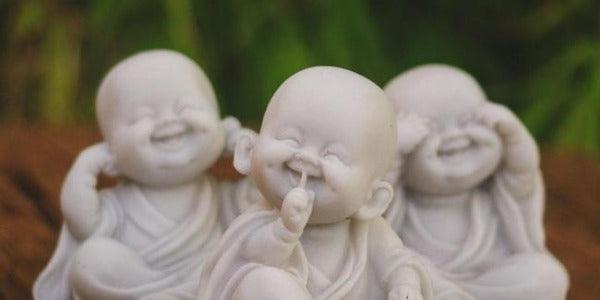It is almost impossible to talk about Buddha or Buddhist sculptures without considering the iconography. Through decorative art, many teachings were passed on and are constant reminders that following the path of enlightenment and spiritual evolution is a daily practice, from you to you. So do the blind, deaf and mute Buddhas - originally figured as the monkeys Mizaru, Kikazaru and Iwazru from Toshogu Shrine in Japan.
Regardless of the associated image, the three sages represent humanity and, in a simplistic way, transmit the precept “do not see evil, do not hear evil and do not speak evil”, which has roots in Chinese philosophy , with the teachings of Confucius . Although, many historians make a connection with Socrates' 3 filters : truth, goodness and usefulness. If what you want to express does not pass through these three filters, it is better not to do it, as it will be a harmful action.

The three wise Buddhas teach: see no evil, hear no evil, and speak no evil."
Following this perspective, the decorative sculptures of blind, deaf and mute Buddhas enter the Buddhist culture not only as teachings to not allow evil to permeate the being, but cast upon us a profound questioning about how we see and deal with evil - which we usually identify as something external, which comes to us through the action of others.
In each position, with asanas (Yoga postures) and mudras (hand gestures) or not, the Buddha invites us to perceive ourselves, so that his representations covering the eyes, ears and mouth do not deprive us of this analysis. . They pay attention to the fact that we are light and shadow and that, therefore, we need to recognize the evil in ourselves and not in the other, because only as we understand our shadows will we know how to welcome them and be able to transform them.

The sculptures invite us to recognize, welcome and transform evil in ourselves.
In the decoration, the three wise Buddhas summon us to meditation, to access our Buddha nature and clarify the darkest aspects of ourselves; because when we distinguish and reconcile ourselves with the evil that is in us, we do not allow another evil source to transpose our being. In view of this, when you are before the Buddhas , understand, welcome and transform the evil in you. It will make a big change in the world!
Find the Buddha that best matches your energy in our online store !
Namaste!
Milene Sousa - Art & Tune











1 comment
Adorei a informação. Gratidão 🙏